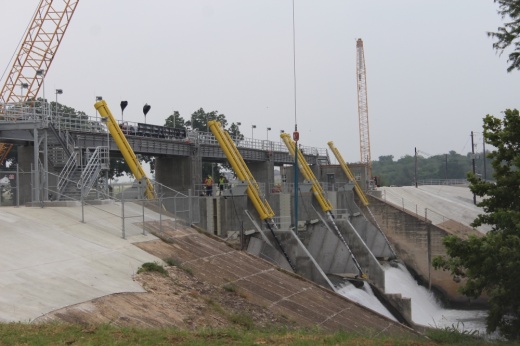The spill gate failure emptied most of the 410-acre reservoir created by the dam on the Guadalupe River, which was built in 1928 southeast of New Braunfels. Water levels at the time were about 40 feet in the deepest parts.
As of May 29, all three floodgates had been installed, and the hydraulic pressure unit, which will power the gates, is still awaiting delivery.
After the dam broke, a partnership among the Guadalupe-Blanco River Authority, the Texas Water Development Board, the Texas Commission on Environmental Quality and a group of residents called the Preserve Lake Dunlap Association was formed.
The PLDA managed to get a taxing district voluntarily created by area residents—the Lake Dunlap Water Control and Improvement District—on the ballot and passed, making the reconstruction possible, LDWCID President Doug Harrison said.
That taxing district encompasses about 500 residences and businesses along the Guadalupe River from the Faust Street Bridge to the dam, Harrison said.
Voters approved the creation of the district in November 2020. Voters who live on or around Lake McQueeney and Lake Placid—which were also created around the same time Lake Dunlap was as part of the Guadalupe Valley Lakes system—created their own WCIDs soon after Lake Dunlap residents did.
Those dams were all put into service between 1928-32. In total, six hydroelectric dams were built at that time.
Zachry Construction Corp., a San-Antonio based construction company, was selected as the contractor in early 2021 and was tasked with rebuilding all three spill gates while widening the existing structure by 15 feet. New concrete armoring was also installed along the existing 1,500-foot core wall.
Lake Dunlap resident John Moore and others said they are excited for its long-awaited completion.
“We’re ready to get all the water back and to be able to enjoy the sights and the fun,” Moore said.
Although Moore said he thinks the taxation was worth it, he acknowledged it was frustrating.
“We’ve had all these years of neglect. The dam wasn’t able to be maintained,” he said. “But then, on the other hand, to me it’s a small price to be able to have a lake in our background. I think the quick action by the PLDA and the property owners to get a solution figured out was what made the difference.”
Harrison said if a gate needs to be replaced or repaired in the future, the LDWCID has the ability to act as a “financing arm” and assist with paying for it.
“We think we’re leaving the future generations a much better solution than we inherited,” Harrison said.
Reinforcing the dam
In an effort to prevent the reconstructed dam from failing again, a number of improvements were added to ensure greater longevity than the original 1928 dam provided, including:
•A complete rebuild of the three spill gates
•Widening the existing structure by 15 feet
•New concrete armoring along the entire length of the existing 1,500-foot wall
•Once the gates are raised—potentially on July 31—it could take three-to-four weeks for the lake to fill back up to normal levels based on current Guadalupe River flow rates.





